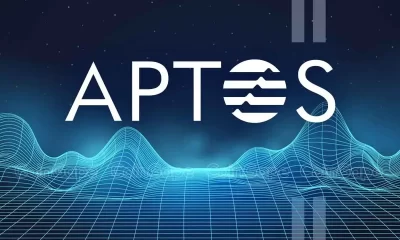AI
How Web3 Cloud is the Answer
Published
3 months agoon
By
admin
Centralized data networks, ones that are owned and/or managed by a single entity, have been structurally broken for years. Why? Single points of failure. If one entity (or even a few) has access to a database, then there is only one “point” to compromise in order to gain full access. This is a serious problem for networks holding sensitive data like customer information, government files, and financial records, and those with control of infrastructure like power grids.
Billions of digital records were stolen in 2024 alone, causing an estimated $10 trillion in damages! Notable breaches include nearly all of AT&T’s customer information and call logs, half of America’s personal health information, 700 million end-user records from companies using Snowflake, 10 billion unique passwords stored on RockYou24, and Social Security records for 300 million Americans.

Source: Statista, 2024
This is not just a private sector issue — governments and crucial national infrastructure also rely on centralized networks. Notable recent breaches include records on 22 million Americans stolen from the U.S. Office of Personnel Management, sensitive government communications from multiple U.S. federal agencies, personal biometric data on 1.1 billion Indian citizens, and the ongoing Chinese infiltration of several U.S. internet service providers.
Although hundreds of billions of dollars are spent each year on cyber security, data breaches are getting larger and happening more frequently. It’s become clear that incremental products cannot fix these network vulnerabilities — the infrastructure must be completely rearchitected.

Source: market.us, 2024
AI magnifies the issue
Recent advancements in generative AI have made it easier to automate everyday tasks and enhance work productivity. But the most useful and valuable AI applications require context, i.e. access to sensitive user health, financial, and personal information. Because these AI models also require massive computing power, they largely can’t run on consumer devices (computer, mobile), and instead must access public cloud networks, like AWS, to process more complex inference requests. Given the serious limitations inherent in centralized networks illustrated earlier, the inability to securely connect sensitive user data with cloud AI has become a significant hurdle for adoption.
Even Apple pointed this out during their announcement for Apple Intelligence earlier this year, stating the need to be able to enlist help from larger, more complex models in the cloud and how the traditional cloud model isn’t viable anymore.
They name three specific reasons:
- Privacy and security verification: Providers’ claims, like not logging user data, often lack transparency and enforcement. Service updates or infrastructure troubleshooting can inadvertently log sensitive data.
- Runtime lacks transparency: Providers rarely disclose software details, and users cannot verify if the service runs unmodified or detect changes, even with open-source tools.
- Single point of failure: Administrators require high-level access for maintenance, risking accidental data exposure or abuse by attackers targeting these privileged interfaces.
Fortunately, Web3 cloud platforms offer the perfect solution.
Blockchain-Orchestrated Confidential Cloud (BOCC)
BOCC networks are like AWS — except built completely on confidential hardware and governed by smart contracts. Though still early days, this infrastructure has been in development for years and is finally starting to onboard Web3 projects and Web2 enterprise customers. The best example of this architecture is Super Protocol, an off-chain enterprise-grade cloud platform managed completely by on-chain smart contracts and built on trustless execution environments (TEEs). These are secure hardware enclaves that keep code and data verifiably confidential and secure.

Source: Super Protocol
The implications of this technology address all of Apple’s concerns noted earlier:
- Privacy and security verification: With public smart contracts orchestrating the network, users can verify whether user data was transported and used as promised.
- Workload and program transparency: The network also verifies the work done within the confidential TEEs, cryptographically proving the correct hardware, data, and software were used, and that the output wasn’t tampered with. This information is also submitted on-chain for all to audit.
- Single point of failure: Network resources (data, software, hardware) are only accessible by the owner’s private key. Therefore, even if one user is compromised, only that user’s resources are at risk.
While cloud AI represents an enormous opportunity for Web3 to disrupt, BOCCs can be applied to any type of centralized data network (power grid, digital voting infrastructure, military IT, etc.), to provide superior and verifiable privacy and security, without sacrificing performance or latency. Our digital infrastructure has never been more vulnerable, but blockchain-orchestration can fix it.
Source link
You may like


Elon Musk Folds X Into xAI, Creating a $113 Billion Juggernaut


Why Trump’s ‘Liberation Day’ tariffs may hurt crypto’s global future


Top 4 Crypto to Buy Now as XRP Price Struggles above $2


US regulators FDIC and CFTC ease crypto restrictions for banks, derivatives


US Authorities Seize $201,400 Worth of USDT Held in Crypto Wallets Allegedly Intended to Support Hamas


Is Bitcoin’s Bull Market Truly Back?
AI
Bittensor spikes 20% after Coinbase announces TAO listing
Published
1 month agoon
February 19, 2025By
admin

Bittensor price rose sharply on Feb. 19 after crypto exchange Coinbase announced the listing of the native token of the decentralized artificial intelligence network.
As most altcoins registered notable gains in the past 24 hour period, Bittensor (TAO) spiked 20% to hit intraday highs of $420. These gains were modest compared to outperformers in the top 100 coins by market cap such as Story, Sonic, Aptos and Floki. However, with double digit gains, Bittensor ranked among the top performers.
The performance saw TAO recoup losses it suffered in the past few days as alts mirrored Bitcoin’s struggles. With 20% upside, bulls wiped most of the accrued losses in the month-to-date period, returning to levels seen when Bittensor price reacted positively to AI news around DeepSeek.
Coinbase to list TAO
A dose of volatility saw Bitcoin rebound above $96,000 and XRP rise 6% amid news of Hashdex’s spot XRP exchange-traded fund approval in Brazil. Cryptocurrencies traded slightly higher as investors awaited the Federal Open Market Committee meeting minutes.
This, along with Coinbase’s upcoming listing of Bittensor on Feb. 20, helped push TAO higher.
In an announcement, the U.S.-based crypto exchange confirmed it would add trading support for TAO on the Bittensor network. The phased launch will offer trading with the TAO/USD pair.
“Trading will begin on or after 9AM PT on February 20 2025 if liquidity conditions are met. Once sufficient supply of this asset is established trading on our TAO-USD trading pair will launch in phases,” Coinbase wrote on X.
Bittensor’s price also soared earlier this month after the project released its Dynamic TAO whitepaper, outlining a major upgrade.
Does TAO listing on Coinbase matter?
Bittensor is a top AI token by market cap, currently the second-largest behind NEAR. Notably, the native token is already listed on Binance, Kraken and other top exchanges. Coinbase listing is nonetheless key as it could give Bittensor further traction.
Besides, the project that launched in 2019 has received investment backing from some of the top venture capital players in the market, including Pantera Capital, Digital Currency Group and Lyrik Ventures.
Grayscale recently noted Bittensor is a crucial project in the AI space as its decentralized model can help increase transparency and democratize access.
According to Grayscale, this is key in the wake of projects such as DeepSeek. While these initiatives highlight the power and potential of open-source AI, the fact that they are centralized companies means there could be risks such as data security and embedded biases. A lack of transparency is another major concern.
Source link
AI
IP crypto surges over 80% following multiple CEX listings, What is IP?
Published
1 month agoon
February 14, 2025By
admin

IP crypto surged by as much as 81.4% in the past 24 hours of trading after the project secured listings on multiple exchanges following its Layer-1 mainnet launch.
According to data from CoinGecko, Story’s token rose to an intraday high of $2.16 on Feb. 14, with its market cap standing at $456 million. The rally was accompanied by a massive surge in demand and activity, with its daily trading volume soaring by over 400,000% to hover around $347 million.
IP was one of the best-performing assets in the crypto market on the day and was trending on Coingecko when writing.
Most of the gains seen over the past day came after the project officially launched its public mainnet after a nearly six-month testnet phase.
The event coincided with the Token Generation Event for its native token, Story tickered IP, which saw over 1 billion tokens enter circulation as part of its initial distribution. Reports indicate that 25% of the initial 1 billion IP supply has been unlocked, with 58.4% allocated to ecosystem development, the community, the foundation, and initial incentive programs.
Following the mainnet launch, IP secured listings on multiple top-tier centralized exchanges, including Coinbase, OKX, KuCoin, Bybit, Bitget, and Bithumb. Most recently, Binance announced the listing of the IP/USDT perpetual contract with up to 25x leverage.
The open interest in the IP futures market has also surged from $92.2k to over $90 million in the past 24 hours, per CoinGlass data.
What is Story Protocol?
Story Protocol is a Layer-1 blockchain designed to revolutionize the $61 trillion intellectual property market by providing a programmable and decentralized framework for managing, trading, and monetizing creative assets.
At its core, the network allows IP holders—including creators, brands, and AI-driven products—to register, tokenize, and govern their digital content on-chain. Users can set custom rules for licensing, modification, and monetization.
The protocol is powered by the IP token, which will serve as the ecosystem’s currency for transactions, governance, and creator rewards. Developers can build on the network, enabling applications such as AI tools, licensing platforms, and decentralized IP marketplaces.
Story Protocol has raised $140 million from investors like a16z and Samsung Next.
Source link
AI
Decentralized AI Opportunity Is ‘Bigger than Bitcoin,’ Says DCG’s Barry Silbert
Published
2 months agoon
February 8, 2025By
admin

Crypto investment magnate Barry Silbert is betting big on decentralized AI, calling it “the next big era of crypto” that could be bigger than even bitcoin.
In a letter to shareholders of his crypto conglomerate Digital Currency Group, Silbert went long on deAI: the crypto industry’s effort to fuse AI innovations with blockchain tech. He believes the tech mashup may pay better dividends for humanity than the closed-off systems being developed by OpenAI and other giants.
“We’re moving from the digital ownership of assets to the decentralized ownership of intelligence and the availability of vast decentralized compute resources,” Siblert wrote in the Q4 letter reviewed by CoinDesk.
The setup reminded Silbert of bitcoin, the best-known and by far biggest cryptocurrency, and the one where he first made his crypto fortune. But instead of a money revolution, deAI could herald a power revolution with crypto as the mechanism to distribute ownership of and governance over powerful AI models.
DCG certainly thinks so. The company has already invested $105 million into over a dozen deAI projects, “and we’re excited to ramp this up in 2025,” Silbert wrote.
He highlighted DCG’s investment in Bittensor – a crypto network that specializes in machine learning and AI applications – as the portfolio company closest to “escape velocity.” Bittensor’s TAO token has many similarities to bitcoin, he wrote.
Notably, TAO’s market cap is $2.7 billion, a rounding error against bitcoin’s nearly $2 trillion valuation.
DCG plans to invest mightily in supporting the Bittensor ecosystem. Silbert pointed out that in November, it spun up a company called Yuma that incubates Bittensor infrastructure projects. And Grayscale, another DCG company, now offers investment products that give exposure to TAO.
Silbert’s Q4 letter capped a year of “rebuilding” at DCG after a long period of tumult spawned by the FTX implosion, which felled its lending business, Genesis. DCG is also a former owner of CoinDesk, having sold to Bullish in late 2023. All five of DCG’s wings had a “successful 2024,” he said.
“The discipline required over the last couple of years has resulted in enhanced infrastructure and more mature processes, improved governance, and a stronger organization focused on executing on our growth initiatives,” Silbert wrote.
Source link

Elon Musk Folds X Into xAI, Creating a $113 Billion Juggernaut

Why Trump’s ‘Liberation Day’ tariffs may hurt crypto’s global future
Bitcoin Plunges Below $84K as Crypto Sell-Off Wipes Out Weekly Gains

Top 4 Crypto to Buy Now as XRP Price Struggles above $2
Ethereum Price Hits 300-Week MA For The Second Time Ever, Here’s What Happened In 2022

US regulators FDIC and CFTC ease crypto restrictions for banks, derivatives

US Authorities Seize $201,400 Worth of USDT Held in Crypto Wallets Allegedly Intended to Support Hamas

Is Bitcoin’s Bull Market Truly Back?

Stablecoin Bills Unfairly Box Out Foreign Issuers Like Tether, Says House Majority Whip

THORChain price prediction | Is THORChain a good investment?

Strategy (MSTR) Holders Might be at Risk From Michael Saylor’s Financial Wizardry

3 Altcoins to Sell Before March 31 to Prepare for Crypto Bull Market

A Big Idea Whose Time Has Finally Come

XRP price may drop another 40% as Trump tariffs spook risk traders

Trader Says Ethereum-Based Altcoin Primed for 240%+ Rally if Major Resistance Level Breaks, Updates XRP Outlook

Arthur Hayes, Murad’s Prediction For Meme Coins, AI & DeFi Coins For 2025

Expert Sees Bitcoin Dipping To $50K While Bullish Signs Persist

Aptos Leverages Chainlink To Enhance Scalability and Data Access

Bitcoin Could Rally to $80,000 on the Eve of US Elections

Sonic Now ‘Golden Standard’ of Layer-2s After Scaling Transactions to 16,000+ per Second, Says Andre Cronje

Institutional Investors Go All In on Crypto as 57% Plan to Boost Allocations as Bull Run Heats Up, Sygnum Survey Reveals

Crypto’s Big Trump Gamble Is Risky

Ripple-SEC Case Ends, But These 3 Rivals Could Jump 500x

Has The Bitcoin Price Already Peaked?

A16z-backed Espresso announces mainnet launch of core product

Xmas Altcoin Rally Insights by BNM Agent I

Blockchain groups challenge new broker reporting rule

Trump’s Coin Is About As Revolutionary As OneCoin

The Future of Bitcoin: Scaling, Institutional Adoption, and Strategic Reserves with Rich Rines

Is $200,000 a Realistic Bitcoin Price Target for This Cycle?
Trending

 24/7 Cryptocurrency News5 months ago
24/7 Cryptocurrency News5 months agoArthur Hayes, Murad’s Prediction For Meme Coins, AI & DeFi Coins For 2025

 Bitcoin2 months ago
Bitcoin2 months agoExpert Sees Bitcoin Dipping To $50K While Bullish Signs Persist

 24/7 Cryptocurrency News3 months ago
24/7 Cryptocurrency News3 months agoAptos Leverages Chainlink To Enhance Scalability and Data Access

 Bitcoin5 months ago
Bitcoin5 months agoBitcoin Could Rally to $80,000 on the Eve of US Elections

 Altcoins2 months ago
Altcoins2 months agoSonic Now ‘Golden Standard’ of Layer-2s After Scaling Transactions to 16,000+ per Second, Says Andre Cronje

 Bitcoin4 months ago
Bitcoin4 months agoInstitutional Investors Go All In on Crypto as 57% Plan to Boost Allocations as Bull Run Heats Up, Sygnum Survey Reveals

 Opinion5 months ago
Opinion5 months agoCrypto’s Big Trump Gamble Is Risky

 Price analysis5 months ago
Price analysis5 months agoRipple-SEC Case Ends, But These 3 Rivals Could Jump 500x


